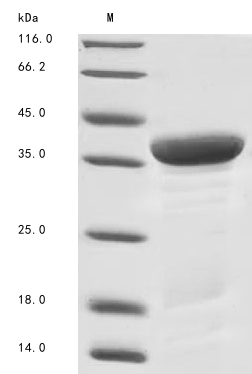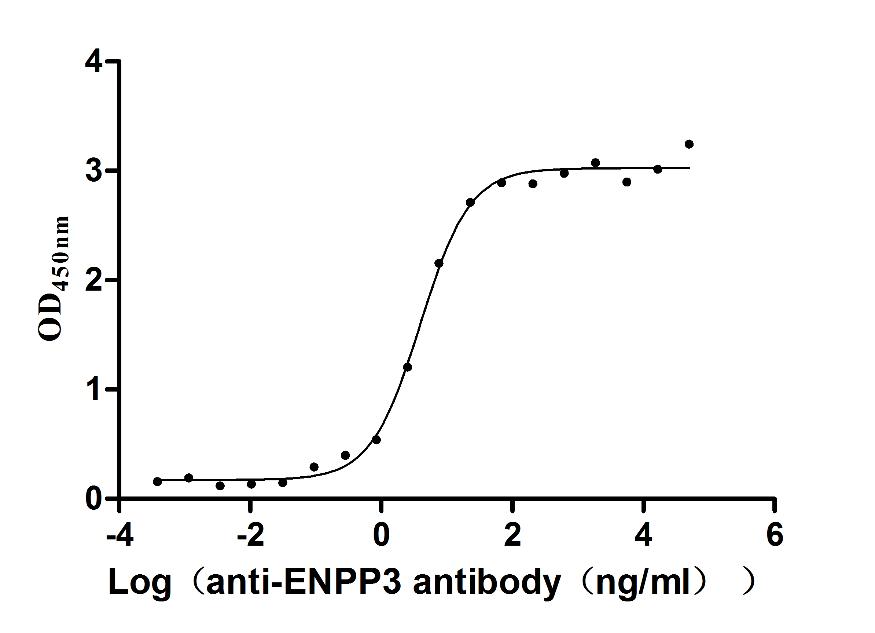Recombinant Human 14-3-3 protein zeta/delta (YWHAZ), partial
-
货号:CSB-EP026293HU1
-
规格:¥1836
-
图片:
-
其他:
产品详情
-
纯度:Greater than 85% as determined by SDS-PAGE.
-
基因名:
-
Uniprot No.:
-
别名:14 3 3 delta; 14 3 3 protein zeta/delta; 14 3 3 protein/cytosolic phospholipase A2; 14 3 3 zeta; 14-3-3 protein zeta/delta; 1433Z_HUMAN; Epididymis luminal protein 4; Epididymis secretory protein Li 3; HEL S 3; HEL4; KCIP-1; KCIP1; MGC111427; MGC126532; MGC138156; Phospholipase A2; Protein kinase C inhibitor protein 1; Tyrosine 3 monooxygenase/tryptophan 5 monooxygenase activation protein; delta polypeptide; Tyrosine 3 monooxygenase/tryptophan 5 monooxygenase activation protein; zeta; Tyrosine 3 monooxygenase/tryptophan 5 monooxygenase activation protein; zeta polypeptide; Tyrosine 3/tryptophan 5 monooxygenase activation protein; zeta polypeptide; YWHAD; YWHAZ
-
种属:Homo sapiens (Human)
-
蛋白长度:Partial
-
来源:E.coli
-
分子量:40.6 kDa
-
表达区域:133-212aa
-
氨基酸序列AAGDDKKGIVDQSQQAYQEAFEISKKEMQPTHPIRLGLALNFSVFYYEILNSPEKACSLAKTAFDEAIAELDTLSEESYK
Note: The complete sequence including tag sequence, target protein sequence and linker sequence could be provided upon request. -
蛋白标签:N-terminal 6xHis-GST-tagged
-
产品提供形式:Liquid or Lyophilized powder
Note: We will preferentially ship the format that we have in stock, however, if you have any special requirement for the format, please remark your requirement when placing the order, we will prepare according to your demand. -
缓冲液:Tris-based buffer,50% glycerol
-
储存条件:Store at -20°C/-80°C upon receipt, aliquoting is necessary for mutiple use. Avoid repeated freeze-thaw cycles.
-
保质期:The shelf life is related to many factors, storage state, buffer ingredients, storage temperature and the stability of the protein itself.
Generally, the shelf life of liquid form is 6 months at -20°C/-80°C. The shelf life of lyophilized form is 12 months at -20°C/-80°C. -
货期:Basically, we can dispatch the products out in 1-3 working days after receiving your orders. Delivery time may differ from different purchasing way or location, please kindly consult your local distributors for specific delivery time.Note: All of our proteins are default shipped with normal blue ice packs, if you request to ship with dry ice, please communicate with us in advance and extra fees will be charged.
-
注意事项:Repeated freezing and thawing is not recommended. Store working aliquots at 4°C for up to one week.
-
Datasheet & COA:Please contact us to get it.
相关产品
靶点详情
-
功能:Adapter protein implicated in the regulation of a large spectrum of both general and specialized signaling pathways. Binds to a large number of partners, usually by recognition of a phosphoserine or phosphothreonine motif. Binding generally results in the modulation of the activity of the binding partner. Induces ARHGEF7 activity on RAC1 as well as lamellipodia and membrane ruffle formation. In neurons, regulates spine maturation through the modulation of ARHGEF7 activity.
-
基因功能参考文献:
- Amount of 14-3-3 proteins is decreased in pineal gland, blood platelets and ileum of patients with ASD. PMID: 28522826
- These results imply that disorder in the N-terminal helices of 14-3-3 zeta is a consequence of the dimer-monomer dynamics and may play a role in conferring chaperone function to 14-3-3 zeta protein. PMID: 29109150
- Knockdown of YWHAZ inhibited cell cycle progression, migration, and the expression of stem cell markers and tumorigenicity was suppressed in tumor-bearing BALB/c nude mice. The expression of YWHAZ was directly down-regulated by miR-30e in resistant ovarian cancer cells. PMID: 30134224
- our data suggest miR-204 and 14-3-3zeta as potential therapeutic targets in osteosarcoma PMID: 29441884
- evidence is lacking to conclude that 14-3-3zeta is a useful marker of tamoxifen resistance. PMID: 28643021
- TRIM21 positively regulated osteosarcoma cell proliferation. Overexpression of TRIM21 enhanced osteosarcoma cell tolerance toward various stresses. YWHAZ protein was identified as a novel interacting partner of TRIM21 and its expression levels were negatively regulated by TRIM21. PMID: 29673441
- several disordered regions of PI4KB become protected from proteolytical degradation upon 14-3-3 binding. PMID: 28864297
- Ectopic expression of miR-451 could inhibit the cell migration and invasion, promoted apoptosis, induced cell-cycle arrest Furthermore, tyrosine3-monooxygenase/tryptophan5-monooxygenase activation protein zeta (YWHAZ) was identified as a direct target of miR-451 PMID: 28981108
- Serum autoantibodies to YWHAZ are produced at substantially greater levels in gastric cancer patients as compared to controls. PMID: 28944820
- Dimerization of 14-3-3 zeta (14-3-3zeta) dimer was disrupted by a double mutant (L12E, M78K). PMID: 29203375
- Results identified YWHAZ as the direct target of miR-613 in hepatocellular carcinoma (HCC). Its overexpression reverses the tumor suppressing role of miR-613 in HCC cells. PMID: 29551505
- 14-3-3zetaoverexpression might be a potential prognostic biomarker for ovarian cancer. PMID: 29214776
- In AML patients, low level of miR-451 is negatively correlated with high levels of c-Myc and YWHAZ, while c-Myc level is positively related to YWHAZ expression. These results suggested that c-Myc dash, verticalmiR-451 dash, verticalYWHAZ/AKT cascade might play a crucial role during leukemogenesis, and reintroduction of miR-451 could be as a potential strategy for AML therapy. PMID: 27764807
- miR-22 exhibits tumor-suppressive effects in hepatocellular carcinoma cells by regulating YWHAZ/AKT/FOXO3a signaling. PMID: 27811373
- our data demonstrate that overexpression of 14-3-3zeta in early stage pre-cancerous breast epithelial cells may trigger an elevated glycolysis and transcriptionally up-regulating LDHA, thereby contributes to human breast cancer initiation. PMID: 27150057
- 14-3-3zeta can bind to the FOXO3a transcription factor to promote the export of the complex to the cytoplasm, leading to enhanced proliferation and migration of tongue cancer cells. PMID: 27080223
- Structure of the complex of phosphorylated liver kinase B1 and 14-3-3zeta has been reported. PMID: 28368277
- These results suggest that the hypoxia/14-3-3zeta/HIF-1alpha pathway plays an important role in portal vein tumor thrombus formation and hepatocellular carcinoma metastasis PMID: 26910835
- 14-3-3zeta recruited YAP and p-LATS to form a complex under high cells density status and 14-3-3zeta other than YAP or phospho-LATS was the key regulatory molecule of this complex. PMID: 27334574
- This study shows that human procaspase-2 interaction with 14-3-3 zeta is governed by phosphorylation at both S139 and S164. PMID: 28943433
- The results highlight a new role of TSC2 in protecting glioblastoma against photodynamic therapy-induced cell death, and TSC2 and YWHAZ as new RIP3 partners. PMID: 27984090
- These results suggest that 14-3-3-zeta is involved in the TLR3-TICAM-1 pathway in promoting multimerization of TICAM-1 for the formation of a TICAM-1 signalosome. PMID: 27058640
- The data indicate that microtubule-bound tau is resistant to 14-3-3zeta-induced tau aggregation and suggest that tau phosphorylation promotes tau aggregation in the brain by detaching tau from microtubules and thus making it accessible to 14-3-3zeta. PMID: 27548710
- Structural interface between LRRK2 and 14-3-3 delta protein has been presented. PMID: 28202711
- 14-3-3zeta-mediated invasion of cancer cells was found to upregulate Snail through the activation of atypical protein kinase C (aPKC). PMID: 27554601
- results have identified a novel mechanism by which 14-3-3sigma maintains the epithelial phenotype by inhibiting Epithelial to Mesenchymal Transition and suggest that this property of 14-3-3sigma might contribute to its function as a tumor suppressor gene. PMID: 27261462
- 14-3-3zeta regulates HIF-1alpha production in hepatocellular carcinoma cells by directly binding to HIF-1alpha and via PI3K/Akt/NF-small ka, CyrillicB signal transduction pathway. PMID: 26884855
- Results indicate that HuR induces 14-3-3zeta translation via interaction with its 3' UTR and that 14-3-3zeta is necessary for stimulation of intestinal epithelial cell migration after wounding. PMID: 27401462
- this study suggests that the down-regulation of 14-3-3 zeta leads to the inhibition of TGFb1- induced contraction by decreasing the expression of total RhoA in TM cells. PMID: 26906158
- loss of expression or even the down-regulation of c-abl, but not WYHAZ, is a fundamental event that leads to genesis and progression of tumors PMID: 26429164
- This study provides the molecular basis for C-Raf C-terminal-derived phosphopeptide interaction with 14-3-3zeta protein and gives structural insights responsible for phosphorylation-mediated protein binding. PMID: 26295714
- 14-3-3z may play an important role in signaling pathway in breast cancer. Also, a high 14-3-3z expression could positively regulate growth factor receptors and protein kinase pathways PMID: 25861752
- Studies show that 14-3-3zeta is overexpressed in oral squamous cell carcinoma and provide evidence that may regulate tumor inflammation and immune response through Stat3 signaling. PMID: 25556369
- Activation of PCTAIRE-1 is mediated through interaction with the phosphorylated form of cyclin Y in complex with 14-3-3. PMID: 26205494
- C-terminal domain of Pdc interacts with the outside surface of the 14-3-3 dimer. PMID: 25971962
- Our findings indicate that YWHAZ could serve as a promising prognostic biomarker in localized PCa to predict poor prognosis PMID: 25156059
- studyconfirmed the interaction of Ser9-phosphorylated GSK3beta with 14-3-3zeta; Ser9-phosphorylation of GSK3beta promoted by 14-3-3zeta is critical for the activation of NF-kappaB pathway PMID: 25138042
- A detailed analysis of the interaction between singly or doubly phosphorylated human tyrosine hydroxylase isoform 1(1-50) peptides and 14-3-3zeta PMID: 25418103
- BIS targeting induces cellular senescence through the regulation of 14-3-3 zeta/STAT3/SKP2/p27 in glioblastoma cells. PMID: 25412315
- Aberrant upregulation of 14-3-3sigma and EZH2 expression serves as an inferior prognostic biomarker for hepatocellular carcinoma. PMID: 25226601
- The 14-3-3zeta-driven contextual changes of Smad partners from p53 to Gli2 may serve as biomarkers and therapeutic targets of TGF-b-mediated cancer progression. PMID: 25670079
- Among the genes found disrupted in this study, there is evidence suggesting that YWHAZ and also the X-linked DRP2 may be considered as novel autism candidate genes. PMID: 23999528
- Data found that the interaction between 14-3-3 zeta and Atg9A is mediated by phosphorylation at Ser761. PMID: 25266655
- miR-375-mediated regulation of 14-3-3zeta contributes to decrease telomerase activity by altering nuclear translocation of TERT. PMID: 24708873
- 14-3-3zeta regulates nuclear trafficking of PP1alpha in mammalian cells PMID: 24956593
- By preventing the inactivation of cofilin, metabolic stress-induced degradation of 14-3-3zeta promotes the conversion of blood monocytes into a hypermigratory, proatherogenic phenotype. PMID: 24812321
- Compared to HL-60 cells, multidrug-resistant HL-60/VCR cells had increased 14-3-3zeta mRNA and protein expression.Silencing of 14-3-3zeta increased the sensitivity of both sensitive and resistant HL-60 cells to TPT-induced apoptosis. PMID: 24603438
- 14-3-3zeta causes synaptic loss by destabilizing microtubules, leading to proteosomal degradation of synaptophysin in the neurons of patients suffering from Alzheimer's disease. PMID: 24367683
- Data suggest that the combined expression of 14-3-3zeta and Hsp27 may be a biomarker for predicting survival in patients with NSCLC, and this combination may have potential as a therapeutic target for NSCLC. PMID: 24804299
- Somatic copy number alterations by whole-exome sequencing implicates YWHAZ and PTK2 in castration-resistant prostate cancer. PMID: 24114522
显示更多
收起更多
-
亚细胞定位:Cytoplasm. Melanosome. Note=Located to stage I to stage IV melanosomes.
-
蛋白家族:14-3-3 family
-
数据库链接:
HGNC: 12855
OMIM: 601288
KEGG: hsa:7534
STRING: 9606.ENSP00000309503
UniGene: Hs.492407
Most popular with customers
-
Recombinant Human Angiopoietin-2 (ANGPT2) (Active)
Express system: Mammalian cell
Species: Homo sapiens (Human)
-
Express system: Mammalian cell
Species: Macaca fascicularis (Crab-eating macaque) (Cynomolgus monkey)
-
Recombinant Human Myosin regulatory light polypeptide 9 (MYL9) (Active)
Express system: Yeast
Species: Homo sapiens (Human)
-
Recombinant Human Dipeptidase 3(DPEP3), partial (Active)
Express system: Mammalian cell
Species: Homo sapiens (Human)
-
Recombinant Human Interleukin-12 receptor subunit beta-1(IL12RB1),partial (Active)
Express system: Mammalian cell
Species: Homo sapiens (Human)



-AC1.jpg)














